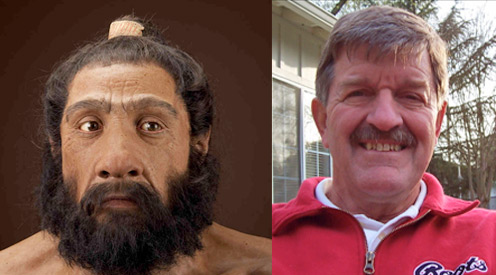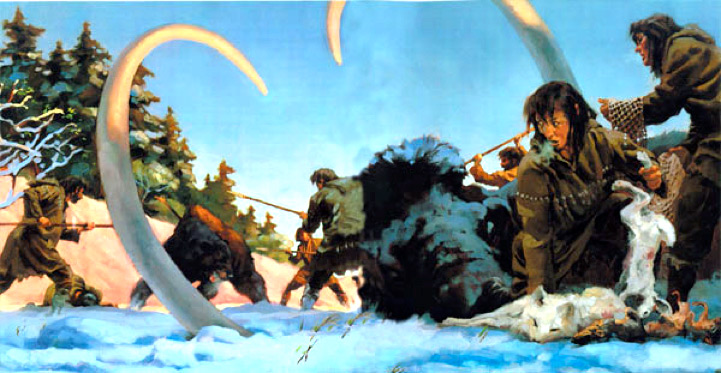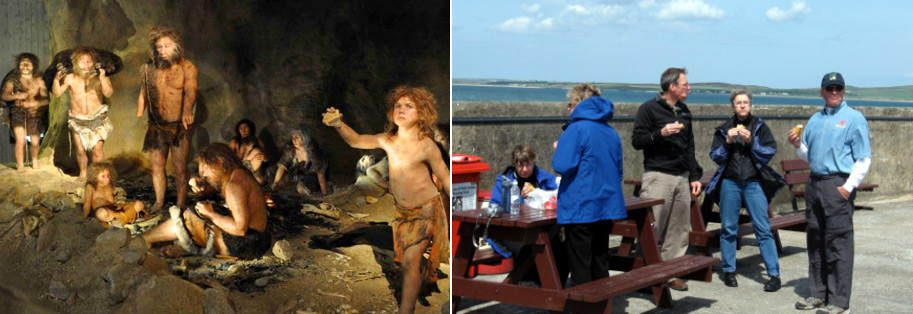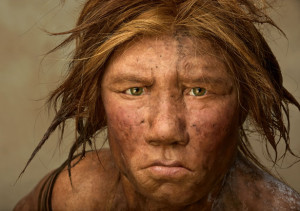Recently my brother John had his genome analyzed by 23 and Me, a commercial laboratory for family genetic research. The results showed that about three percent of his genetic inheritance, and by extension that of my sister and me, comes from Neanderthal ancestors. We had heard that new evidence from the quickly developing field of human genetics suggested that non-African populations often had an admixture of Neanderthal blood, and we wondered if our own Whitelaw line could claim this heritage. Our three percent puts us in the mainstream; it now appears that most European and Asian people have between one and five percent Neanderthal inheritance.

A Neanderthal Man, about 70,000 BC; John Whitelaw, 2007 AD
Learning that I was biologically connected to Neanderthals made me want to learn more about them, and how their history is intertwined with that of modern humans. It is likely that Neanderthals evolved in the Near East, after their ancestors left Africa, so people of African descent do not have any Neanderthal inheritance. Fully evolved Neanderthals populated Europe starting in about 200,000 BC.
About sixty thousand years ago, a small band of African humans also left Africa, following the footsteps of their very distant forbears. When they reached the Levant (modern day Israel, Palestine, Lebanon, and Syria.), about 40,000 years ago, they encountered Neanderthals. Until recently, it was thought that sexual unions of Neanderthals and modern humans, if they had even happened, would not produce offspring. However, now both the human genome and the Neanderthal genome have been mapped, so comparisons are possible. And the evidence suggests that Neanderthals and modern humans created descendants who exist to this day – us!

We know from fossils that Neanderthals looked somewhat different from modern humans. They were well adapted to conditions of the ice age, with their internal organs protected from the cold by their heavily muscled torsos and short limbs. They lived around the edges of forests, where they hunted large game animals such as deer, horse, and large, wild cattle. They made spears with stone points, that were probably too heavy and clumsy to throw. Scientists believe that they waited in ambush for animals to pass close by, and then attacked them with spear thrusts. This was a dangerous business. Neanderthal fossil bones show many fractures and other injuries; interestingly, they are similar to the types of injuries suffered by modern rodeo cowboys, who also have frequent close encounters with wild animals.
This direct, brutal hunting method does not mean that Neanderthals were unintelligent savages. In fact, their brains were 20 percent larger than modern humans, and their skulls were anatomically similar. The areas of the brain responsible for complex thought were just as advanced as ours. The construction of the Neanderthal’s throat suggests that they had the anatomical equipment for speech, and thus probably communicated with language. From archaeological evidence, we know that they produced art in the form of painted shells. They carefully buried their dead, suggesting that they formed close human bonds. They built shelters of large animal bones for protection from the cold; they had fire; they sewed clothes from animal skins. Studies of fossils shows that they tended those who had been injured. In other words, they thought and acted much like our homo sapiens ancestors did in the Stone Age.

A Neanderthal clan about 40,000 BC; The Whitelaw clan on the Isle of Islay, Scotland, 2007 AD. From left to right: Susan, Carol, Jan, Nancy, John.
Neanderthals disappear from the fossil record about 30,000 years ago. Why, with their bodies well adapted to ice age conditions, and their cognitive and social strengths, did the Neanderthals become extinct? This is a question that is currently engaging much scholarly debate. An older theory looks to the coincidence that Neanderthals disappeared about the same time that modern humans first appeared in Europe. The implication is that modern humans, who were presumably smarter and more advanced, overcame them in the struggle for survival, either by genocide or by taking over their hunting ranges.
More recently, scientists have been considering the effects of changes in climate. About 40,000 years ago, the earth underwent a series of rapid climate changes, which had the overall effect of reducing the wooded forests which had been the home of Neanderthals and increasing vast expanses of open grasslands. The Neanderthal strategy of ambushing game was less successful in open fields, and so their numbers dwindled as they retreated to the shrinking forest areas. Some scientists think that they never encountered the newly arrived modern humans at all, since populations were small and Europe was vast.
Scientific research is ongoing, and is sure to provide more fascinating discoveries about our Neanderthal inheritance, including perhaps the Neanderthal influence on our susceptibility to various diseases.
References
BBC. Neanderthal.
http://www.bbc.co.uk/sn/tvradio/programmes/horizon/neanderthal_prog_summary.shtml
Edwards, Owen. Smithsonian Magazine, March, 2010. The Skeletons of Shalimar Cave.
http://www.smithsonianmag.com/arts-culture/the-skeletons-of-shanidar-cave-7028477/?all
Smithsonian Museum of Natural History. Homo Neanderthalensis
http://humanorigins.si.edu/evidence/human-fossils/species/homo-neanderthalensis
Vergano, Dan. National Geographic. April 22, 2014. Neanderthals lived in small isolated communities, Gene analysis shows.
http://news.nationalgeographic.com/news/2014/04/140421-neanderthal-dna-genes-human-ancestry-science/
Zimmer, Carl. PBS, Nova Science Now. Sept. 20, 2012. Are Neandethals Human?
http://www.pbs.org/wgbh/nova/evolution/are-neanderthals-human.html

